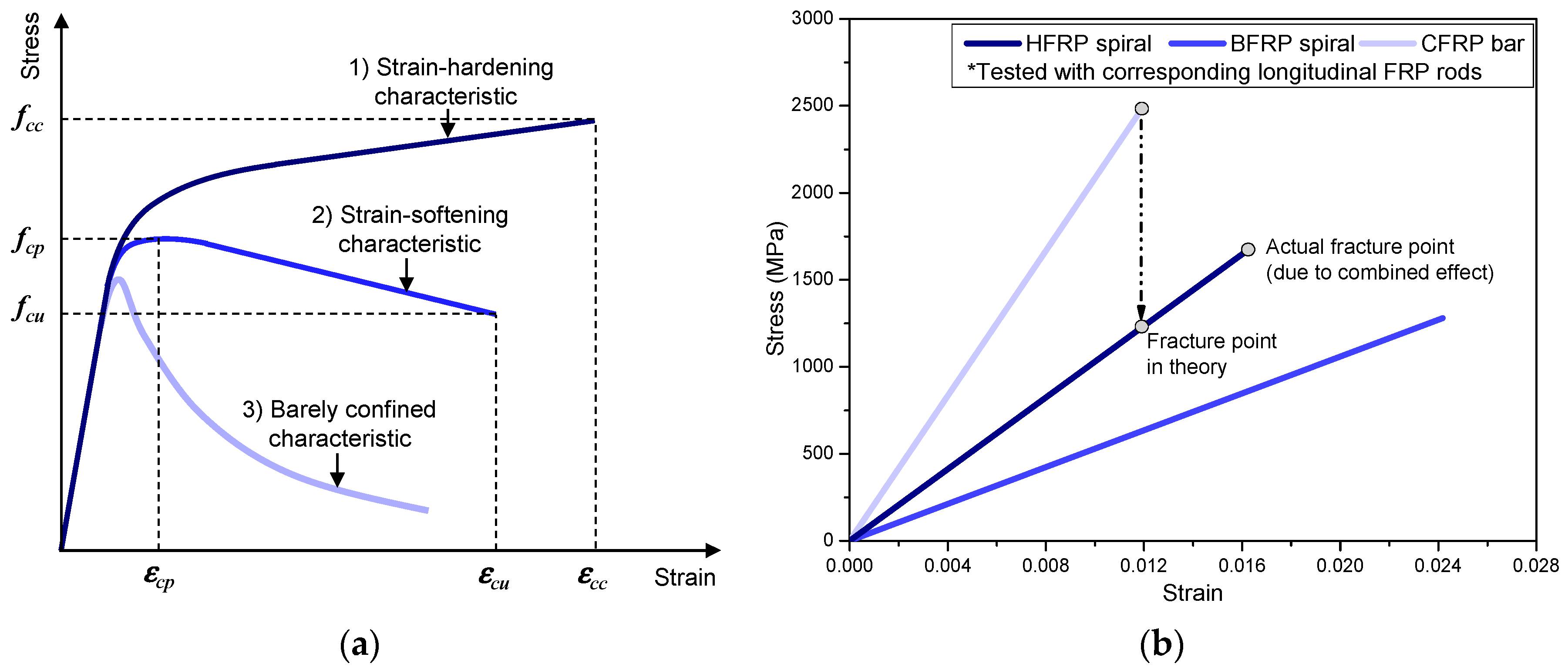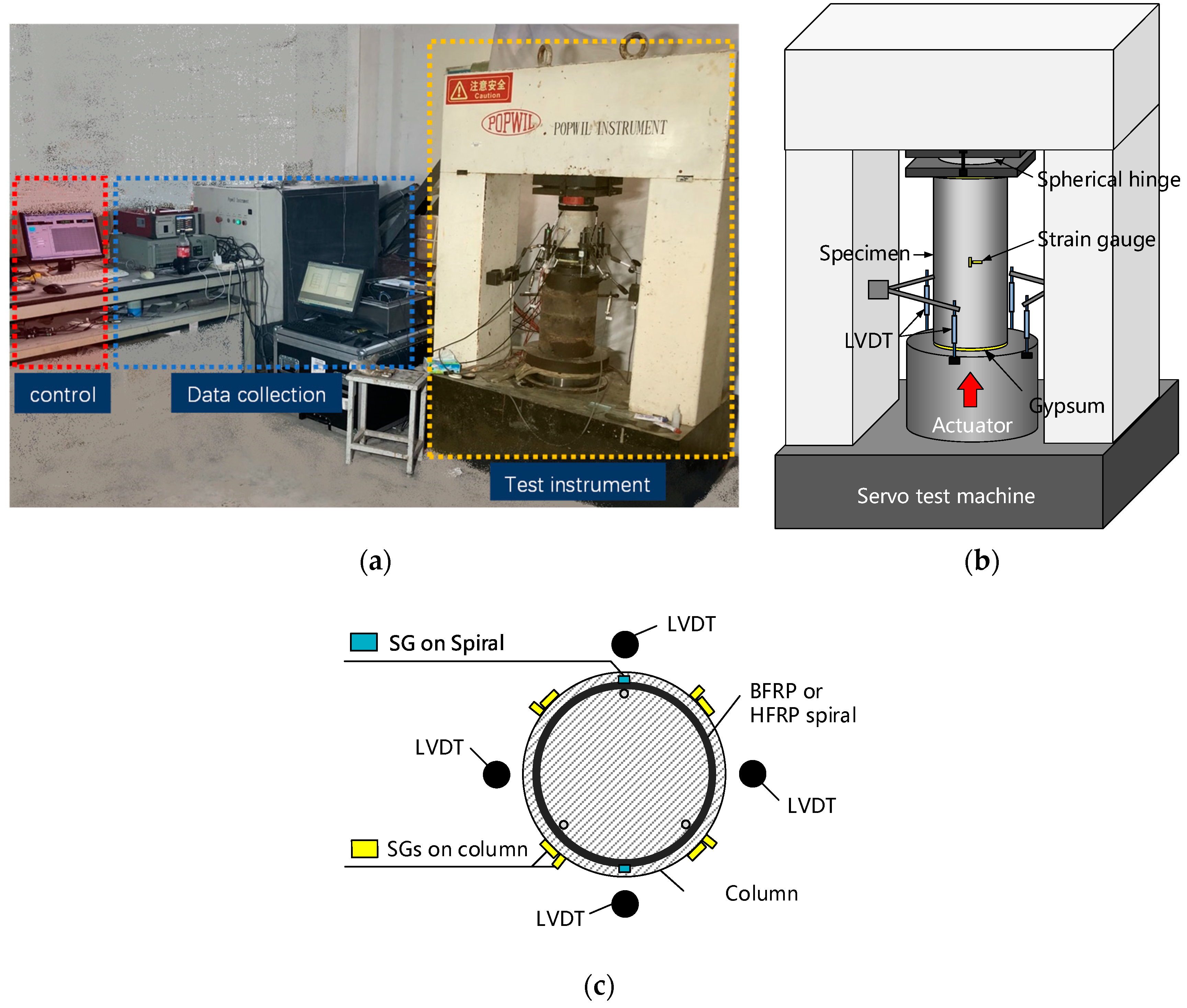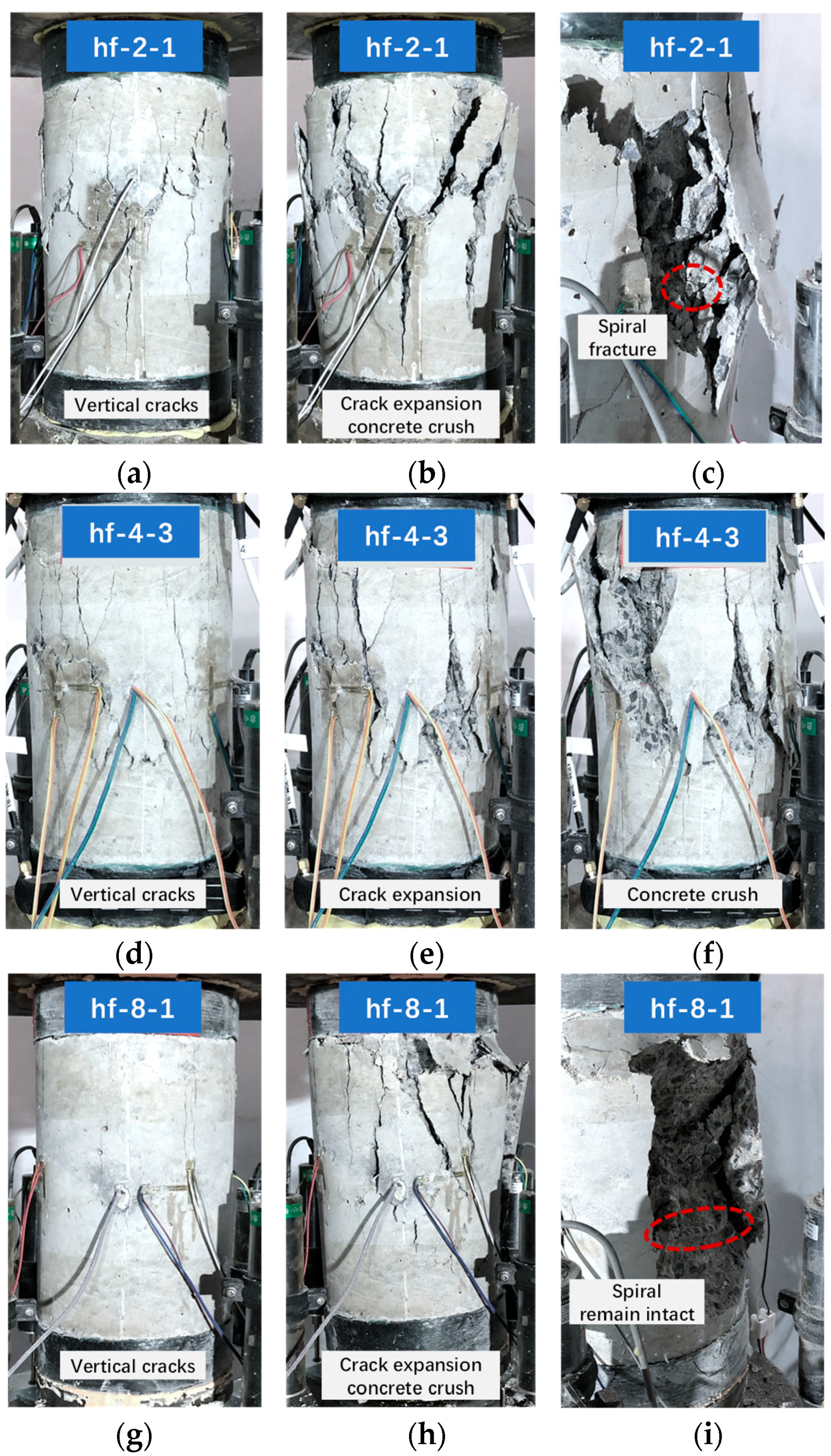Experimental Study on Compressive Behavior of Concrete Cylinders Confined by a Novel Hybrid Fiber-Reinforced Polymer Spiral
Abstract
:1. Introduction
2. Experimental Program
2.1. Specimen Design
2.2. Material Properties
2.3. Test Instruments and Setup
3. Test Results and Discussion
3.1. Stress–Strain Curves and Failure Modes of Cylinders
- (1)
- hf-2 cylinder type
- (2)
- hf-4 and hf-6 cylinder types
- (3)
- hf-8 cylinder type
3.2. Strain Development Mechanism of HFRP Spiral in Concrete Cylinders
3.3. Ultimate Strain of HFRP Spiral
3.4. Evaluation of Ultimate Stress and Strain of HFRP-Spiral-Confined Concrete Cylinders
- (1)
- Existing models
- (2)
- Evaluation for cylinders with strain-hardening characteristics
- (3)
- Evaluation for cylinders with strain-softening characteristics
4. Conclusions
- (1)
- The compressive failure mode and mechanism of the HFRP-spiral-confined cylinders were similar to those of BFRP-spiral-confined cylinders, indicating that the design method of HFRP-spiral-confined concrete could be similar to that of common FRP-spiral-confined cylinders.
- (2)
- The ultimate strain of the HFRP spiral (tested as a single rod) was larger than that of the corresponding CFRP bar. This proved that an advantageous composite effect could be obtained with the HFRP spiral. The maximum strain of the HFRP spirals in concrete cylinders reached over 70% of the ultimate strain values, relatively larger than that of the BFRP spirals, indicating that an ideal in-service strength could be obtained with the HFRP spiral.
- (3)
- Most of the existing models overestimated the ultimate stress and strain of the FRP-spiral-confined cylinders. Wu’s model, derived from the ultimate Poisson’s ratio based on the strain compatibility principle, gave the most accurate prediction, both for cylinders with strain-hardening and for those with strain-softening characteristics.
Author Contributions
Funding
Institutional Review Board Statement
Informed Consent Statement
Data Availability Statement
Conflicts of Interest
Appendix A
References
- Lam, L.; Teng, J.G. Stress-strain model for FRP-confined concrete under cyclic axial compression. Eng. Struct. 2009, 31, 308–321. [Google Scholar] [CrossRef]
- Wu, Y.-F.; Wei, Y. General Stress-Strain Model for Steel- and FRP-Confined Concrete. J. Compos. Constr. 2015, 19, 04014069. [Google Scholar] [CrossRef]
- Fardis, M.N.; Khalili, H.H. FRP-encased concrete as a structural material. Mag. Concr. Res. 1982, 34, 191–202. [Google Scholar] [CrossRef]
- Toutanji, H.A. Stress-strain characteristics of concrete columns externally confined with advanced fiber composite sheets. ACI Mater. J. 1999, 96, 397–404. [Google Scholar]
- Huang, L.; Yin, P.; Yan, L.; Kasal, B. Behavior of hybrid GFRP-perforated-steel tube-encased concrete column under uniaxial compression. Compos. Struct. 2016, 142, 313–324. [Google Scholar] [CrossRef]
- Li, X.-H.; Wu, G.; Wang, S.; Yu, X.-H. Flexural Behavior of Hollow-Core Slabs Strengthened with Prestressed Basalt FRP Grids. J. Compos. Constr. 2019, 23, 04019016. [Google Scholar] [CrossRef]
- Qiudong, W.; Libin, W.; Bohai, J.; Zhongqiu, F. Modified effective notch stress method for fatigue evaluation of rib-deck welds integrating the critical distance approach. J. Constr. Steel Res. 2022, 196, 107373. [Google Scholar] [CrossRef]
- Liu, J.; Xu, T.; Guo, Y.; Wang, X.; Chen, Y.F. Behavior of circular CFRP-steel composite tubed high-strength concrete columns under axial compression. Compos. Struct. 2019, 211, 596–609. [Google Scholar] [CrossRef]
- Jiang, Y.; Wang, X.; Li, B.; Higashi, Y.; Taniguchi, K.; Ishida, K. Estimation of reinforcing effects of FRP-PCM method on degraded tunnel linings. Soils Found. 2017, 57, 327–340. [Google Scholar] [CrossRef]
- Dong, Z.; Wu, G.; Zhao, X.-L.; Zhu, H.; Lian, J.-L. Durability test on the flexural performance of seawater sea-sand concrete beams completely reinforced with FRP bars. Constr. Build. Mater. 2018, 192, 671–682. [Google Scholar] [CrossRef]
- Li, Y.L.; Teng, J.; Zhao, X.; Raman, R.S. Theoretical model for seawater and sea sand concrete-filled circular FRP tubular stub columns under axial compression. Eng. Struct. 2018, 160, 71–84. [Google Scholar] [CrossRef]
- Benzaid, R.; Mesbah, H.-A. The confinement of concrete in compression using CFRP composites—Effective design equations. J. Civ. Eng. Manag. 2014, 20, 632–648. [Google Scholar] [CrossRef] [Green Version]
- Ma, G.; Li, H.; Yan, L.; Huang, L. Testing and analysis of basalt FRP-confined damaged concrete cylinders under axial compression loading. Constr. Build. Mater. 2018, 169, 762–774. [Google Scholar] [CrossRef]
- Silva, M.A.G.; Rodrigues, C.C. Size and relative stiffness effects on compressive failure of concrete columns wrapped with glass FRP. J. Mater. Civ. Eng. 2006, 18, 334–342. [Google Scholar] [CrossRef]
- Zeng, J.-J.; Ye, Y.-Y.; Guo, Y.-C.; Lv, J.-F.; Ouyang, Y.; Jiang, C. PET FRP-concrete-high strength steel hybrid solid columns with strain-hardening and ductile performance: Cyclic axial compressive behavior. Compos. Part B-Eng. 2020, 190, 107903. [Google Scholar] [CrossRef]
- Zhou, J.-K.; Lin, W.-K.; Guo, S.-X.; Zeng, J.-J.; Bai, Y.-L. Behavior of FRP-confined FRP spiral reinforced concrete square columns (FCFRCs) under axial compression. J. Build. Eng. 2022, 45, 103452. [Google Scholar] [CrossRef]
- Pham, T.M.; Hadi, M.N.S.; Youssef, J. Optimized FRP Wrapping Schemes for Circular Concrete Columns under Axial Compression. J. Compos. Constr. 2015, 19, 04015015. [Google Scholar] [CrossRef] [Green Version]
- Jiang, S.-F.; Zeng, X.; Shen, S.; Xu, X. Experimental studies on the seismic behavior of earthquake-damaged circular bridge columns repaired by using combination of near-surface-mounted BFRP bars with external BFRP sheets jacketing. Eng. Struct. 2016, 106, 317–331. [Google Scholar] [CrossRef]
- Cao, Q.; Li, H.; Lin, Z. Study on the active confinement of GFRP-confined expansive concrete under axial compression. Constr. Build. Mater. 2019, 227, 116683. [Google Scholar] [CrossRef]
- Wu, G.; Wu, Z.-S.; Luo, Y.-B.; Sun, Z.; Hu, X.-Q. Mechanical properties of steel-FRP composite bar under uniaxial and cyclic tensile loads. J. Mater. Civ. Eng. 2010, 22, 1056–1066. [Google Scholar] [CrossRef]
- Ibrahim, A.I.; Wu, G.; Sun, Z.-Y. Experimental study of cyclic behavior of concrete bridge columns reinforced by steel basalt-fiber composite bars and hybrid stirrups. J. Compos. Constr. 2016, 21, 04016091. [Google Scholar] [CrossRef]
- Zhang, Y.; Wei, Y.; Zhao, K.; Ding, M.; Wang, L. Analytical model of concrete-filled FRP-steel composite tube columns under cyclic axial compression. Soil Dyn. Earthq. Eng. 2020, 139, 106414. [Google Scholar] [CrossRef]
- Sun, Y.; Fu, J.; Sun, Z.; Zhang, J.; Wei, Y.; Wu, G. Flexural behavior of concrete beams reinforced by partially unbonded steel-FRP composite bars. Eng. Struct. 2022, 272, 115050. [Google Scholar] [CrossRef]
- Sun, Z.-Y.; Wu, G.; Wu, Z.-S.; Zhang, M. Seismic behavior of concrete columns reinforced by steel-FRP composite bars. J. Compos. Constr. 2011, 15, 696–706. [Google Scholar] [CrossRef]
- Tang, Y.; Wu, G.; Sun, Z.; Zhang, Y. Seismic Performance of Underwater Bridge Columns Strengthened with Prestressed-Concrete Panels and FRP Reinforcement. J. Compos. Constr. 2019, 23, 04019019. [Google Scholar] [CrossRef]
- Cao, Y.-G.; Hou, C.; Liu, M.; Jiang, C. Effects of predamage and load cyclic on compression behavior of fiber reinforced polymer-confined concrete. Struct. Concr. 2021, 22, 1784–1799. [Google Scholar] [CrossRef]
- Jiang, C.; Wu, Y.-F.; Jiang, J.-F. Effect of aggregate size on stress-strain behavior of concrete confined by fiber composites. Compos. Struct. 2017, 168, 851–862. [Google Scholar] [CrossRef]
- ASTM D7205/D7205M-06; Standard Test Method for Tensile Properties of Fiber Reinforced Polymer Matrix Composite Bars. ASTM International: West Conshohocken, PA, USA, 2016.
- Dong, H.-L.; Wang, D.; Wang, Z.; Sun, Y. Axial compressive behavior of square concrete columns reinforced with innovative closed-type winding GFRP stirrups. Compos. Struct. 2018, 192, 115–125. [Google Scholar] [CrossRef]
- Teng, J.; Chen, J.F.; Smith, S.T.; Lam, L. FRP: Strengthened RC structures. Front. Phys. 2002, 266, 31–46. [Google Scholar]
- C469-14; Standard Test Method for Static Modulus of Elasticity and Poisson’s Ratio of Concrete in Compression. ASTM International: West Conshohocken, PA, USA, 2014.
- C39M-21; Standard Test Method for Compressive Strength of Cylindrical Concrete Specimens. ASTM International: West Conshohocken, PA, USA, 2021.
- Wu, G.; Lü, Z.T.; Wu, Z.S. Strength and ductility of concrete cylinders confined with FRP composites. Constr. Build. Mater. 2006, 20, 134–148. [Google Scholar] [CrossRef]
- Saadatmanesh, H.; Ehsani, M.R.; Li, M.W. Strength and Ductility of Concrete Columns Externally Reinforced With Fiber Composite Straps. ACI Struct. J. 1994, 91, 434–447. [Google Scholar]
- Mander, J.B.; Priestley, M.J.N.; Park, R. Theoretical Stress-Strain Model for Confined Concrete. J. Struct. Eng. 1988, 114, 1804–1826. [Google Scholar] [CrossRef] [Green Version]
- Lam, L.; Teng, J.G. Design-oriented stress–strain model for FRP-confined concrete. Constr. Build. Mater. 2003, 17, 471–489. [Google Scholar] [CrossRef]
- Teng, J.; Jiang, T.; Lam, L.; Luo, Y.Z. Refinement of a design-oriented stress-strain model for FRP-confined concrete. J. Compos. Constr. 2009, 13, 269. [Google Scholar] [CrossRef] [Green Version]
- Wei, Y.-Y.; Wu, Y.-F. Unified stress–strain model of concrete for FRP-confined columns. Constr. Build. Mater. 2012, 26, 381–392. [Google Scholar] [CrossRef]
- Ozbakkaloglu, T.; Lim, J.C. Axial compressive behavior of FRP-confined concrete: Experimental test database and a new design-oriented model. Compos. Part B-Eng. 2013, 55, 607–634. [Google Scholar] [CrossRef]






| Cylinder Type | FRP Spiral | Concrete Cylinders | ||||
|---|---|---|---|---|---|---|
| Type | s (mm) | ρf (%) | Failure Mode | fcp (or fcc) (MPa) | εcp (or εcc) | |
| pc | \ | \ | \ | CC | 44 | 0.004 |
| hf-2 | HFRP spiral | 23 | 4.0 | SF | 36 (fcc) | 0.011 (εcc) |
| hf-4 | HFRP spiral | 46 | 2.0 | SF | 34 | 0.005 |
| hf-6 | HFRP spiral | 69 | 1.3 | SF | 32 | 0.005 |
| hf-8 | HFRP spiral | 92 | 1.0 | CC | 32 | 0.004 |
| bf-2 | BFRP spiral | 23 | 7.6 | SF | 41 (fcc) | 0.013 (fcc) |
| bf-4 | BFRP spiral | 46 | 3.8 | SF | 34 | 0.005 |
| bf-6 | BFRP spiral | 69 | 2.5 | SF | 32 | 0.005 |
| bf-8 | BFRP spiral | 92 | 1.9 | CC | 31 | 0.004 |
| Component Type | Density (g/cm3) | Diameter (μm) | Tensile Strength (MPa) | Elastic Modulus (GPa) | Elongation Rate (%) |
|---|---|---|---|---|---|
| basalt fiber | 2.63 | 13 | 2250 | 90 | 2.5 |
| carbon fiber | 1.85 | 6 | 3000 | 210 | 1.4 |
| vinyl epoxy resin | 1.06 | — | 95 | 3.6 | 6.1 |
| Spiral Type | Fiber Type | df (mm) | Af (mm2) | ff (MPa) | Ef (GPa) | εfu | Ef·Af (GPa·mm2) |
|---|---|---|---|---|---|---|---|
| HFRP spiral | basalt and carbon | 5.8 | 26.4 | 1667 | 101 | 0.016 | 2667 |
| BFRP spiral | basalt | 7.9 | 49.0 | 1281 | 53 | 0.024 | 2597 |
| Cylinder Type | εfu,a | εfu,a/εfu (%) | fcu,a | εcu,a | Cylinder Type | εfu,a | εfu,a/εfu (%) | fcu,a | εcu,a |
|---|---|---|---|---|---|---|---|---|---|
| hf-2 | 0.008 | 49% | 36 | 0.011 | bf-2 | 0.012 | 49% | 41 | 0.013 |
| hf-4 | 0.012 | 73% | 30 | 0.006 | bf-4 | 0.012 | 51% | 28 | 0.010 |
| hf-6 | 0.011 | 72% | 23 | 0.011 | bf-6 | 0.007 | 28% | 24 | 0.012 |
| hf-8 | 0.011 | 70% | 9 | 0.017 | bf-8 | 0.011 | 47% | 8 | 0.018 |
| Model | hf-2 | bf-2 | ||||||
|---|---|---|---|---|---|---|---|---|
| fcc′ (MPa) | Err. | εεcc′ | Err. | fcc′ (MPa) | Err. | εεcc′ | Err. | |
| Lam and Teng (2003) [36] | 103 | 0.66 | 0.037 | 2.68 | 104 | 0.47 | 0.038 | 1.94 |
| Wu et al. (2006) [33] | 80 | 0.28 | 0.011 | 0.10 | 80 | 0.14 | 0.012 | −0.08 |
| Teng et al. (2009) [37] | 100 | 0.61 | 0.030 | 2.03 | 102 | 0.45 | 0.032 | 1.48 |
| Wei and Wu (2012) [38] | 84 | 0.34 | 0.025 | 1.49 | 84 | 0.19 | 0.025 | 0.94 |
| Yu-Fei Wu et al. (2015) [2] | 86 | 0.38 | 0.021 | 1.12 | 87 | 0.23 | 0.022 | 0.70 |
| Cylinder | fcp′ (MPa) | Err. | εcp′ | Err. | fcu′ (MPa) | Err. | εcu′ | Err. |
|---|---|---|---|---|---|---|---|---|
| hf-4 | 62 | 0.07 | 0.009 | 1.04 | 55 | 0.07 | 0.010 | 0.63 |
| hf-6 | 56 | 0.03 | 0.008 | 0.58 | 48 | 0.21 | 0.008 | −0.26 |
| bf-4 | 62 | 0.02 | 0.009 | 0.78 | 56 | 0.11 | 0.010 | −0.01 |
| bf-6 | 56 | −0.01 | 0.007 | 0.37 | 48 | 0.12 | 0.008 | −0.31 |
Publisher’s Note: MDPI stays neutral with regard to jurisdictional claims in published maps and institutional affiliations. |
© 2022 by the authors. Licensee MDPI, Basel, Switzerland. This article is an open access article distributed under the terms and conditions of the Creative Commons Attribution (CC BY) license (https://creativecommons.org/licenses/by/4.0/).
Share and Cite
Tang, Y.; Lu, X.; Wei, Y.; Hou, S. Experimental Study on Compressive Behavior of Concrete Cylinders Confined by a Novel Hybrid Fiber-Reinforced Polymer Spiral. Polymers 2022, 14, 4750. https://doi.org/10.3390/polym14214750
Tang Y, Lu X, Wei Y, Hou S. Experimental Study on Compressive Behavior of Concrete Cylinders Confined by a Novel Hybrid Fiber-Reinforced Polymer Spiral. Polymers. 2022; 14(21):4750. https://doi.org/10.3390/polym14214750
Chicago/Turabian StyleTang, Yu, Xiaowan Lu, Yang Wei, and Shitong Hou. 2022. "Experimental Study on Compressive Behavior of Concrete Cylinders Confined by a Novel Hybrid Fiber-Reinforced Polymer Spiral" Polymers 14, no. 21: 4750. https://doi.org/10.3390/polym14214750





